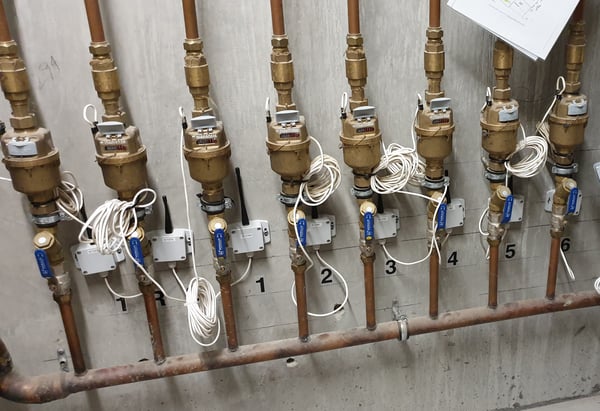Apartment sub-metering - why you need to plan ahead with new builds
by A D Riley, on Sep 24, 2020 1:28:01 PM
.png?width=2240&name=Untitled%20design%20(20).png)
New builds - they can be challenging, especially when it's a set of new apartments that will be sold or leased out to individuals. There are a lot of boxes to tick, and the planning stage of any complex multi-tenant structure is about making sure that nothing gets missed. The very last thing building managers want is to realise an important installation was missed and they have to go back and do it again. This is especially true when it comes to metering - the measurement of utilities such as water, electricity and gas.
Direct metering vs master metering
Older buildings that were erected decades ago have direct metering; the utility owns each apartment’s meter, and each resident pays directly to the utility based on their individual rate. On the other hand, buildings using ‘master metering’ don’t have metering of individual units; the entire building is charged as a whole.
But what if, in the apartment building, there are two one-bedroom apartments next to each other, one owned by an elderly woman who spends most of her time reading and hardly ever turns on her TV set, the other by a young couple with two computers, two window air conditioners, a heavily-used TV and gaming station, phone chargers and more. Should they both be charged the same amount for electric usage?
From the point of view of the landlord, property manager or body corporate, master metering can lead to problems when utility costs go up, or when enough of the owners or tenants start using inefficient air conditioners or heaters.
The benefits of apartment sub-metering
Meeting these challenges is achieved by sub-metering, and it needs to be one of the earliest boxes ticked during the design stage of a development project. Sub-metering allows landlords or property management companies to bill each unit individually while getting one bill of its own. The meters need to be installed before the build project is completed, because if it's not addressed early on, there can be problems with sub-metering installation.
What tends to happen with new builds is project managers don't consider who will be paying for what once the building is finished and the residents have moved in. That's an issue for the body corporate, landlords or property managers to sort out, and they often realise too late that sub-metering should have been installed during the build phase. That's why, when an multi-tenant building is being developed, those who will be managing it down the track need to ensure the sub-metering box is ticked early on.
Arthur D. Riley supplies apartment sub-metering solutions that are based on a building's or individual's needs. The meters monitor utility use, and the data can be used for billing. Building managers and body corporates use the data from these meters to chase down debt, or to ensure that apartment owners and tenants are paying for what they use on an individual basis.

The meters are monitored remotely, meaning a significant amount of time - and often, hassle - is saved by not having to visit each apartment and physically read the meter. The monitoring is done by ADR; we put units in place to do 'smart reads', then we collate the data and, typically, send it to the building manager on a monthly basis.
Why install sub-meters?
One of the main problems sub-metering solves is that of chasing debt. When a multi-tenant building has been charged a monthly amount from a particular utility, and there are a number of individuals in separate flats, the building manager needs to know how much to charge each one. In the example of the elderly lady and the young couple, the sub-metering data will clearly spell out who's used what.
The data can also be used to settle any conflicts; if the young couple complain that they're paying more than their elderly neighbour, the building manager can provide proof of their individual electricity usage and justify the bill.
Settling the issue of who pays for what is not the only benefit to installing sub-metering during the build phase. Others include:
- The time and hassle saved by not having to read meters physically, and individually
- The money saved by not having to pay someone to read the meters
- Data management - ADR can help to analyse the data, spot patterns and trends, and produce invoices
- High quality, accurate data
- Making utility payment easier for the residents as well as the managers
- Real-time readings for all apartments on the same day
The process of physically reading water, electricity and gas meters is time-consuming and expensive. A remote sub-metering management system in place eliminates the need to visit each apartment thereby speeding up the process and reducing costs. Not only that, but the readings can be done in real-time so that they can be set up to coincide with external bills. If a building manager knows they'll receive an electricity bill on the 20th of each month, a reading can be supplied for that date, so that it dovetails with that of the electricity supplier.
Sub-metering makes management of building utilities easier and more streamlined, assists with conflict resolution and is a cost-effective time saver. If it's part of a building development project from the beginning, it will provide building management and landlords with significant benefits down the road.
If you'd like to find out more about ADR's apartment sub-metering solutions and how to get sub-metering installed, get in touch to start a discussion.


